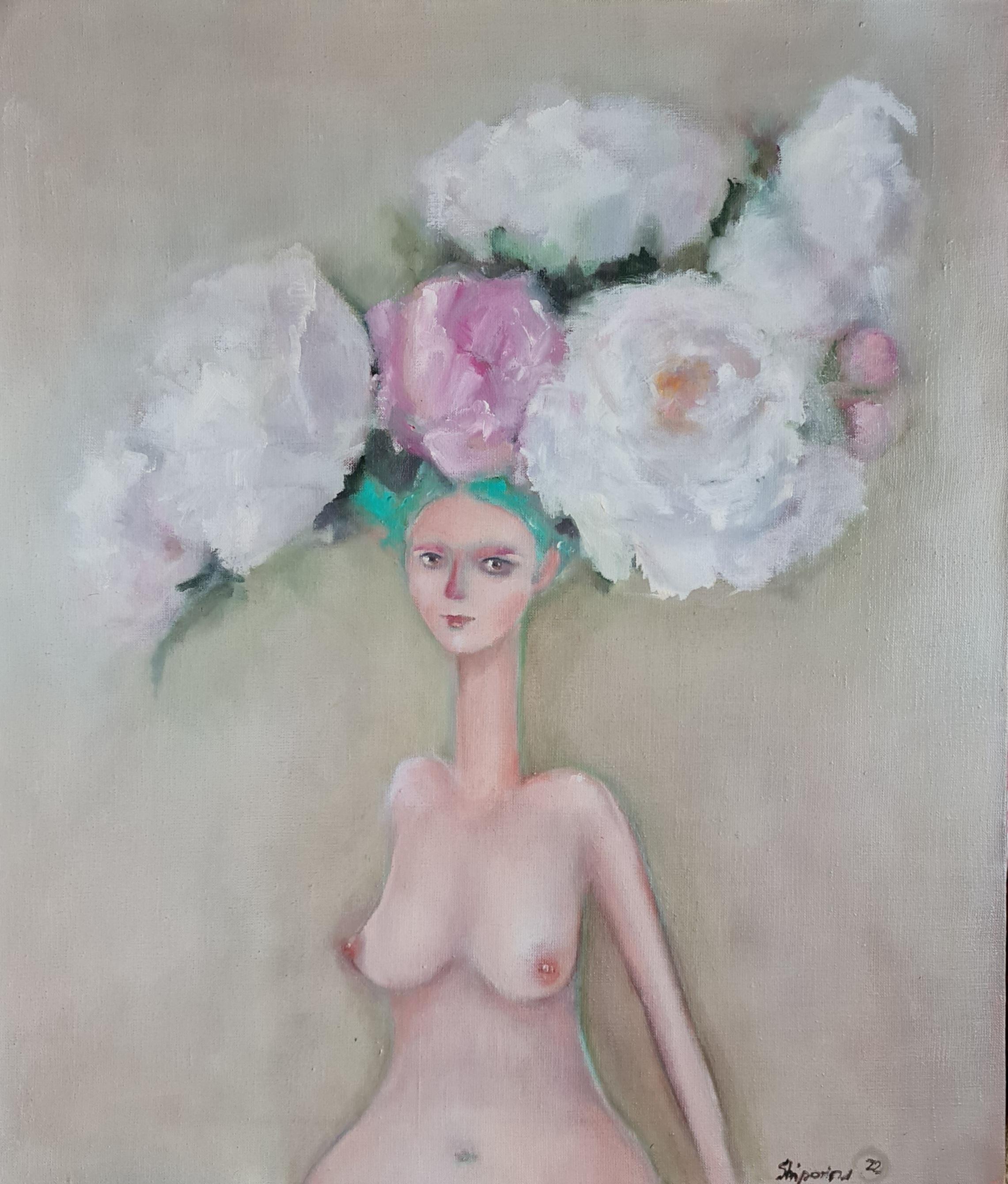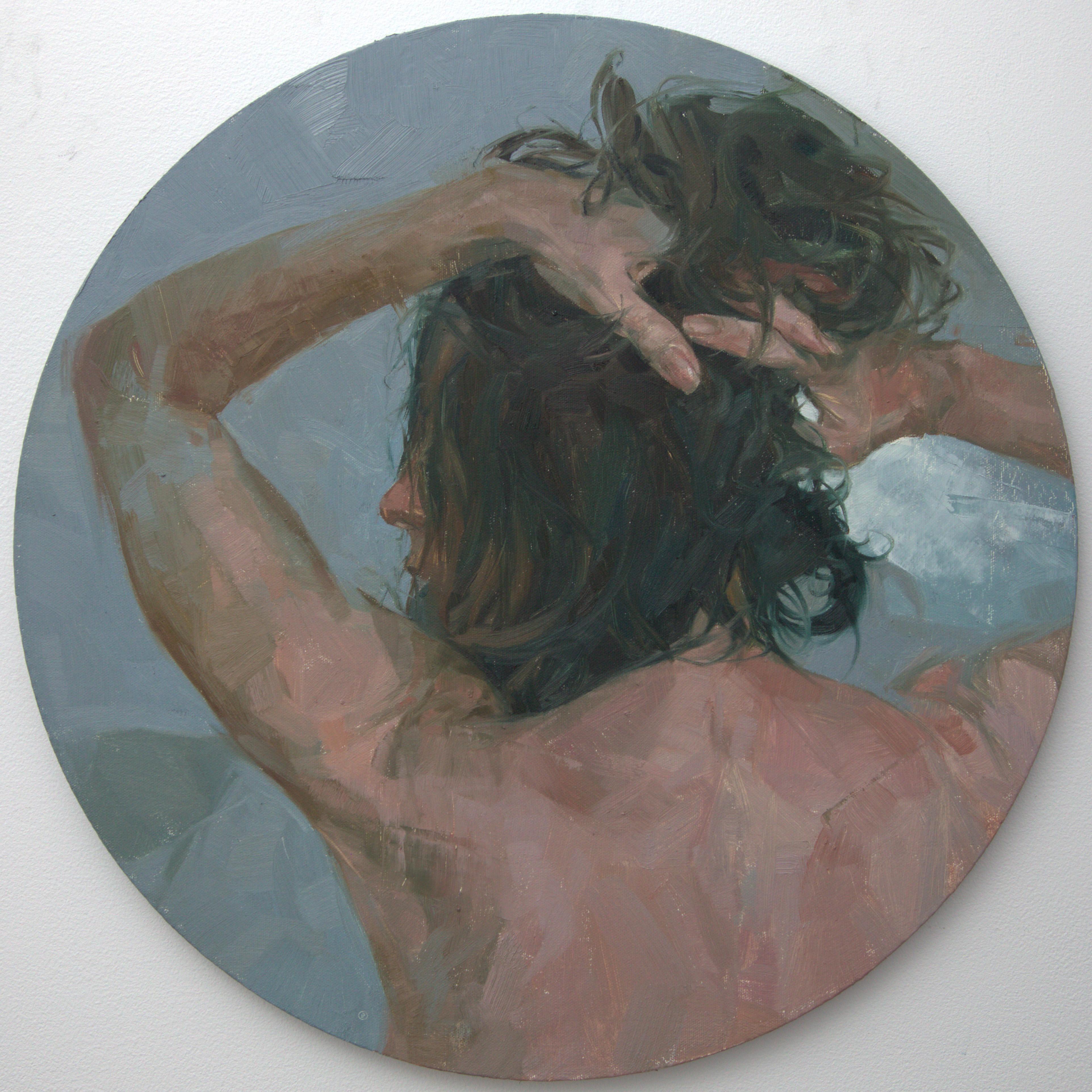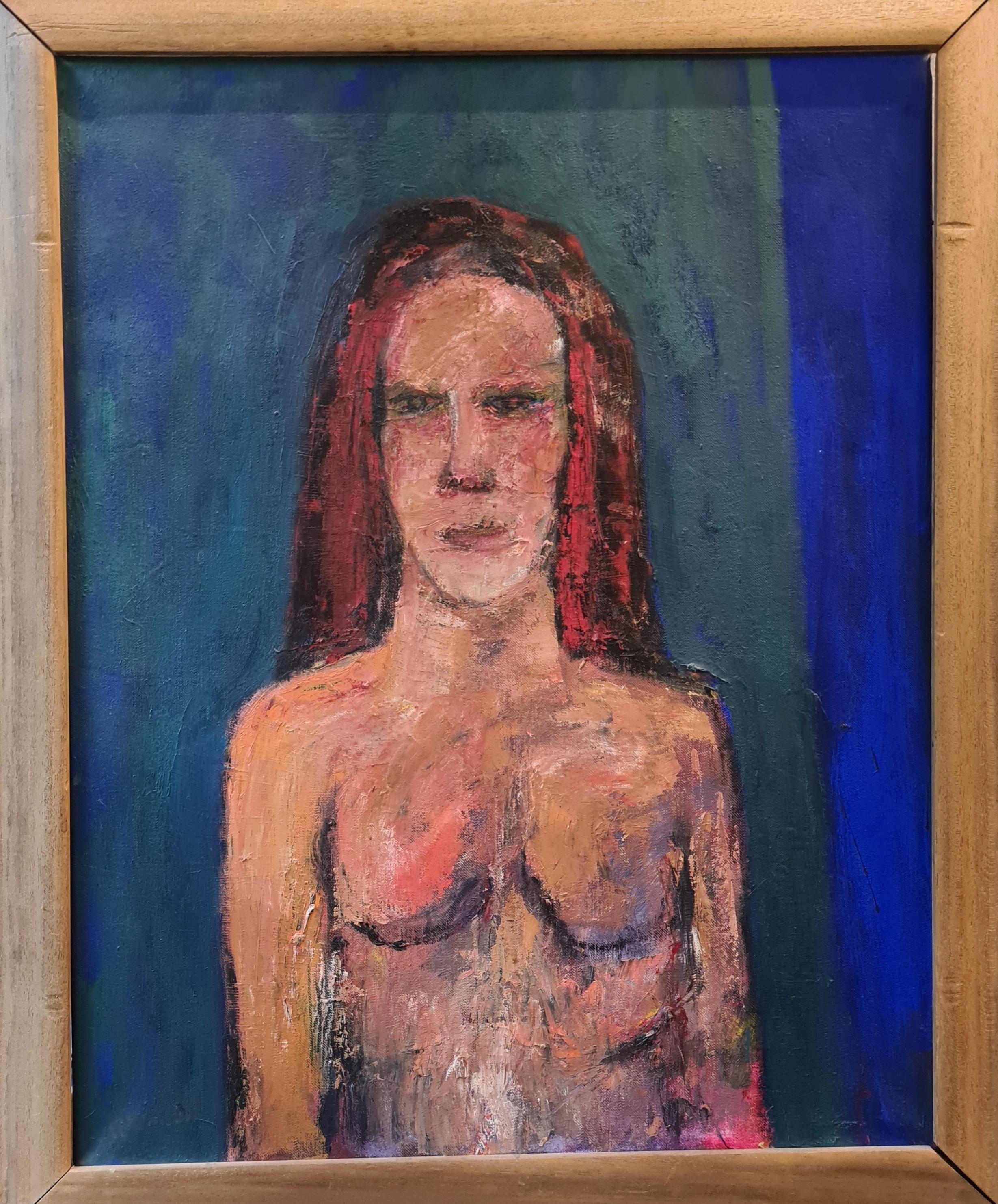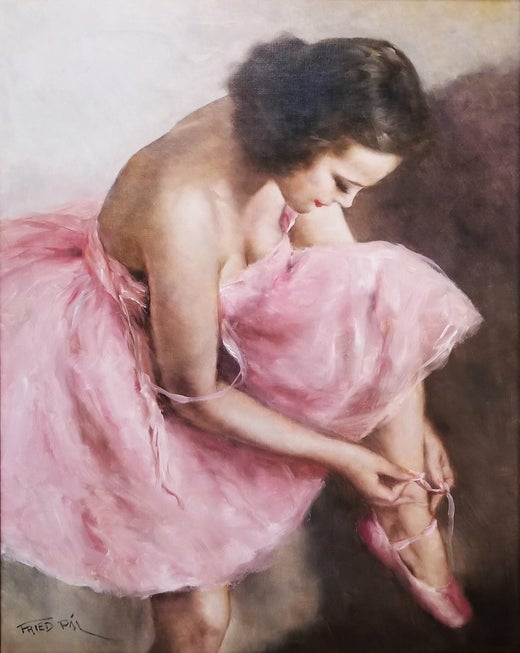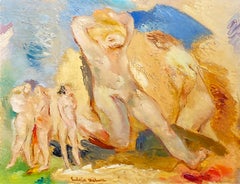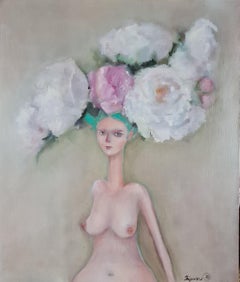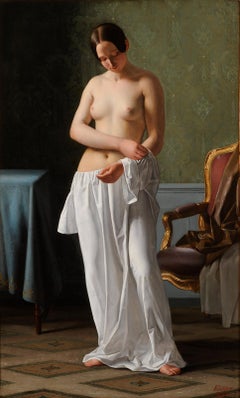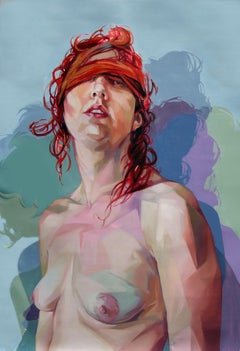
Pin Up Girl
View Similar Items
Video Loading
Want more images or videos?
Request additional images or videos from the seller
1 of 11
Pal FriedPin Up Girl
About the Item
- Creator:Pal Fried (1893 - 1976, American)
- Dimensions:Height: 30 in (76.2 cm)Width: 24 in (60.96 cm)
- Medium:
- Movement & Style:
- Period:
- Condition:
- Gallery Location:Missouri, MO
- Reference Number:1stDibs: LU747311546582
Pal Fried
Pál Fried (16 June 1893 in Hungary – 6 March 1976 in New York City) was a Hungarian artist best known for his eroticized paintings of female dancers and nudes. Pál Fried was born in Budapest in 1893. He received his art education at the Académie hongroise des arts (Hungarian Academy of Arts) where he was a pupil of Hugo Pohl who became one of his major influences. While under Pohl's direction, he executed many portraits of female nudes and Orientalist works. Later he studied in Paris at the Académie Julian, where he was the pupil of Claude Monet and Lucien Simone. In Paris, he was greatly influenced by the French Impressionists, especially Pierre-Auguste Renoir and Edgar Degas. This inspired him to prepare many paintings of ballerinas, dancers and circus performers.Fried emigrated to the United States in 1946 after World War II, where he taught at the New York Academy of Art. He prepared portraits of American celebrities such as Marilyn Monroe. Through his work in portraiture, he gained considerable financial success.He became a U.S. citizen in 1953. He lived in Los Angeles and New York City and died on 6 March, 1976 in New York, NY. He worked in oils and pastels and experimented with light and movement. His oil paintings were usually of dancers, nudes, and portraits, and while his subjects were primarily female, he also painted Paris, seascapes, cowboys and landscapes of the American West as well as Orientalist subject matter. He signed his paintings, as is usual in Hungarian, with his surname first as "Fried Pál". At times, this particular artist would make several, almost identical versions of the same oil painting, except he would use slightly different facial expressions and/or would try different colour schemes.
About the Seller
5.0
Vetted Seller
These experienced sellers undergo a comprehensive evaluation by our team of in-house experts.
Established in 1970
1stDibs seller since 2017
141 sales on 1stDibs
Typical response time: 22 hours
More From This SellerView All
- NudesLocated in Missouri, MONudes By. Salcia Bahnc (Polish, American, 1898-1976) Signed Lower Middle Unframed: 14 x 18 inches Framed: 23 x 26 inches Painter, illustrator, printmaker, teacher. Born in Dukla, Poland. Though she was born in Dukla, a town in south-eastern Poland, she moved to Prsemysl, one of the largest and most ancient cities of southern Poland, at a young age. Her mother was reportedly descended from the "Van Ast" family, a Dutch dynasty that produced several artists, including Balthasar van der Ast (1593/4 - 1657). According to one art historian she came to New York at the age of five (c. 1903), and another, at the age of eight (c. 1906). Her family was Jewish and reportedly quite wealthy. Why they would have left imperial Austria, under whose sovereignty either of her proposed birth cities were under, is unknown. However, while these areas did not suffer the pogroms typical in neighboring imperial Russia, the Austro-Hungarian empire had become much more anti-Semetic, which may have hasten there departure. How, according to one source, they ended up living in the Jewish ghetto of New York is extremely puzzling. Did they loose their wealth to some business disaster? Where they forced to leave it behind? Was there some familial tragedy? We may never know. In her youth she lived first in New York City and then in Boston, Massachusetts, where her family had relatives. It is reported that when she was in fourth grade she was found to be so competent in drawing that for the next two years she taught a drawing class after school for the other children. In Boston, Bahnc's mother eventually remarried and moved the family to Chicago where the young artist was primarily raised. In Chicago she worked during the days as a sales clerk in a department store. At night she put herself through school at the School of the Art Institute of Chicago (SAIC) and taught at her former alma mater after her graduation during the years 1923-1929. She also studied at the Chicago Academy of Fine Art. She took up design work and began exhibiting painted silk creations at a private Chicago gallery (probably Thurber, see below). The first museum exhibitions she is known to have participated in were held at the Art Institute of Chicago. During this period she became known for her portraits. Originally a resident alien, she was naturalized at the district court of Chicago, Illinois in July of 1913. In 1920 she lived on East Ontario Street in Chicago in a neighborhood filled with art studios and artists, including James Allen Saint-John (1872-1957), Paul Bartlett (1881-1965), Pauline Palmer (1867-1938), and George Ames Aldrich (1872-1941). It is in Chicago that she saw her greatest success as an artist. In 1927, Chicago art dealer Chester H. Johnson said of her work: "The Art of Salcia Bahnc is a sincere manifestation of the spirit we know as 'Modernism' . . . . . . She is the spirit of the Age, not its Fashion." Local reviewers agreed, one going as far to say that her exhibition was " . . . the most interesting one man show by a young artist that has ever been presented to Chicago, and I keep telling myself that New York will get her if we don't watch out." She was apparently a favorite and friend of art critic Clarence Joseph Bulliet (1883-1952), who authored a number of books and articles that praised Bahnc's work. Bulliet was central in introducing and popularizing modern art in the mid-western United States. In his book Apples and Madonnas: Emotional Expression in Modern Art (1935) he called Bahnc a "A thorough Expressionist." A year later in his book The Significant Moderns and Their Pictures (1936) he noted that one of her paintings of a nude was ". . . powerful in its elemental brutality." During this period other critics reported positively on the work she was producing. Ida Ethelwyn Wing reported in a volume of the Delphian Text (1930) that Bahnc, was without doubt, ". . . the most vigorous and intensively original of the American Expressionists." Paul Masserman and Maxwell Baker said of her in their work The Jews come to America (1932) that she was part of a group of artists that were "Chief among modern Jewish painters. . . " Salcia Bahnc traveled back and forth to Europe during the late 1920s and into the 1930s, a period when she faced the rise of totalitarianism. She wrote about this fact to a fellow artist to whom she commented " . . . about the difficult art scene in Paris . . . . . . and the growing power of fascism." In 1930 she was maintaining a studio in New York City at 1218 East 53rd Street and a residence in Brooklyn, Long Island. She returned to France where she married a French citizen and writer named Eugene Petit (b. 1901) and bore a son there named Alain Petit (b. 1934). She again returned to the United States in November of 1937 and traveled back to France after a brief stay in America. During her stay she continued to exhibit in Chicago, where Quest Galleries gave her a solo show. Like so many ex-patriot authors and artists who were living in Paris, she found herself trapped in France (first in Paris, then in Mayenne) following the German invasion in 1940. Being of Jewish extraction the situation could prove to be quite dangerous if she were reported or discovered by German authorities. She and her husband were able to obtain passports and escape to Portugal where in August of 1941 they boarded the S. S. Escambion to return to America. In 1940, American Export Lines, owners of the Escambion, discontinued its normal Mediterranean routes and placed their ships into service sailing from Lisbon, Portugal to New York City. Over the next two years (1940 - 1941) their ships played an important role in transporting thousands of people who were trying to escape the Nazi regime before America's own entry into World War II. One survivor, Ludwig Lowenberg, who sailed on the Escambion on the same day that Bahnc did, reported the ordeal his family endured getting to Lisbon to his own descendants: "[The family] received their American visa on May 28, 1941, only three days before the U.S. consulate in Stuttgart closed for the duration of World War II. They left Berlin on June 23, 1941, traveling for 27 hours on a locked train to Paris. There they were forced to spend an additional night in the locked train until their coach was attached to a train headed for San Sebastian in Spain. After an overnight hotel stay in San Sebastian, the train (now no longer locked) continued to Lisbon. All in all it took six days from Berlin to Lisbon. They remained for four weeks in Lisbon until they embarked on the Excambion for New York." Bahnc had given up her citizenship during her time in France and was forced to reapply for naturalization once again upon her return. She was living in New York City at 101 West 85th Street when she was re-naturalized in April of 1947. Exactly how much of her artwork was lost in Europe is not known. Clearly, she would not have been able to bring much, if anything, with her during her escape. One writer had noted that between 1930 and 1934 she had worked hard to prepare a large group of new works for a show in Paris. Between those, and what she would have produced during the next six years, the actual amount of the loss might have been staggering. Bahnc's 1942 exhibition with Julio de Diego included works recalling the suffering going on in Europe. One work in the exhibition was a portrait of the painter Katherine Dudley, who, at the time, was reportedly interned near Paris. In the later years of her career she worked extensively as a teacher and illustrator of children's books. In 1950 she taught at the Evanston Art Center, where she lead a demonstration in portrait painting. She authored or illustrated a number of works during and after World War II, including: The House in the Tree and Other Stories of Places, People and Things (1941); Claude Of France: The Story Of Debussy For Young People (1948); Time for Poetry (1951); Hidden Silver (1952); From Many Lands - The Children's Hour, Volume 9 (1969); and That Boy (no date). She returned to teach at the School of the Art Institute of Chicago during 1943-44 and 1947-53; and taught later at the Garrison Forest School in Garrison, Maryland, from 1955-57. Bahnc was known to have exhibited widely, both in Europe and in America. Her known lifetime exhibitions include: The Art Institute of Chicago, Chicago, IL, 1919-29, 1942 (The 53rd Annual; and Room of Chicago Art: Exhibition of Paintings by Salcia Bahnc and Julio de Diego), 1943; Chicago Architectural...Category
20th Century Expressionist Nude Paintings
MaterialsOil, Canvas
Price Upon Request - Portrait of General George Duke of Gordon, G.C.B.By Ramsay Richard ReinagleLocated in Missouri, MORamsay R. Reinagle (English, 1775-1862) Portrait of Lord George, Duke of Gordon, G.C.B., Founder of the Famous Scottish Regiment of "Gordon Highlanders" in 1795, 1828 27 x 22 inches ...Category
1820s Land Portrait Paintings
MaterialsOil, Canvas
- Making BubblesBy Joseph Henry HatfieldLocated in Missouri, MOJoseph Henry Hatfield (American, 1863-1928) Making Bubbles Signed Lower Right 16 x 13 inches 23 x 19 inches At the turn of the century, Joseph Henry Hatfield was well known around C...Category
Early 20th Century Impressionist Figurative Paintings
MaterialsOil, Canvas
Price Upon Request - AlphonsineBy Robert KushnerLocated in Missouri, MORobert Kushner (American, b. 1949) Alphonsine, 1983 30 x 22 inches without frame 32.75 x 25 inches with frame Titled Lower Left Signed and dated Mid Lower Right A member of the Patt...Category
1980s American Modern Mixed Media
MaterialsPaper, Mixed Media, Acrylic
Price Upon Request - Uncle SamBy Syd CockellLocated in Missouri, MOThis is an original oil on velvet painting created c. 1942. Syd Cockell was an accomplished American illustrator during World War II.Category
1940s American Realist Portrait Paintings
MaterialsOil
- MadonnaLocated in Missouri, MOMadonna by Louis Carl Hvasta (1913-1993) Unframed: 37" x 24" Framed: 47.75" x 34" Signed and Dated Lower Left Frame was Hand Made by the artist himself. A local Californian Artist, ...Category
20th Century American Impressionist Portrait Paintings
MaterialsPanel, Oil
Price Upon Request
You May Also Like
- figurative painting with a naked beauty and flowers delicate flowersLocated in Sempach, LUthe picture is beautiful. If you love flowers this is the picture for you. Tenderness and love.Category
2010s Modern Nude Paintings
MaterialsOil, Canvas
- Model undressingLocated in BELEYMAS, FRJulius EXNER (Copenhagen, 1825 - Copenhagen, 1910) Model stripping Oil on canvas H. 122 cm; L. 74 cm Signed and dated 1842 lower right Exhibition: most likely Charlottenborg Salon of 1845, under number 110, titled Modelfigur, awarded with a silver medal Provenance: Emilio Fernando Bolt (c.1860 - 1944), acquired from the artist around 1900, then by descent Our painting was produced as part of the summer sessions organized between 1839 and 1850 by Christoffer Wilhelm Eckersberg (1783-1853), the master of Danish painting of the first half of the 19th century, in his private studio-apartment on the ground floor. floor at the Royal Academy of Fine Arts in Copenhagen. The master brought together a few students there between June and September, rented one or two models for the season, which were painted from different angles, the artists (including Eckersberg himself) sitting side by side. Eckersberg used to paint a fairly small version, the pupils of the larger formats. The work fits more generally into the legendary context of the research and reforms carried out by Eckersberg concerning the studies of nudes and in particular of female nudes, to make this exercise a genre of painting in its own right. Following his two-year stint in Jacques-Louis David's studio in Paris in 1811, Eckersberg had been made aware of work on the nude and in particular on live models, in natural light, while in Denmark the drawings were then only made from casts of antique models or other mannequins. In 1822, when he had been a professor there since 1818, it was he who had the Royal Academy of Copenhagen authorize the study of nudes, no longer in the evening by candlelight, but in natural light; from 1833, it was still he who allowed students to work on nude female models, even if the official authorization of the Academy did not take place until 1839. It was this same year that he instituted his summer sessions, on a private basis, to orient his painting and that of his students towards a new conception of the representation of models: even if the nude remains the real theme, it does not however, this is more than just an academic exercise. The subject is placed in a contemporary interior, with a rather sophisticated decor, and occupied with an intimate activity (it is this type of intimate vein that we will find later in Degas or Cassatt for example); thus in our painting, the young woman is supposed to take off her clothes to wash. The objective is that the viewer forgets that the master and his students are painting a model during a posing session, and that he instead has the impression of being alone with the model, but invisible, almost like a voyeur in spite of himself. Moreover, in these paintings, the model never looks towards the spectator, inducing a psychological distance with him, whereas model and artist are actually physically very close. On the other hand, it is not a question of idealized nudes either, even if Eckersberg, proof of his debt to the antique, chooses fairly classic models and poses. The sensuality is real and very present, with dreamy, even innocent, and timeless expressions (the models do not seem to have a defined age), suave and slow attitudes and movements, and especially with clothes that hide or reveal skillfully parts of the female body: upper buttocks, pronounced hips... Made by an artist under 20, our sensual painting is probably one of the most beautiful and spectacular produced by the students of Eckersberg during these summer sessions. With a perfect balance between the firmness of an ancient statue (it recalls the Venus de Milo) and the softness of the feminine forms, highlighted by a harmonious palette, it captures the attention with many details: the almost photographic folds white clothing...Category
1840s French School Nude Paintings
MaterialsCanvas, Oil
- Entanglement in Red and Blue- 21st Century Contemporary Portrait of a womanLocated in Nuenen, Noord BrabantAlejandro Casanova Entanglement in Red and Blue 130 x 89 cm oil on canvas The Spanish artist Alejandro Casanova lives and works in Tenerife, where ...Category
2010s Contemporary Portrait Paintings
MaterialsCanvas, Oil
- Playing around- 21st Century Contemporary Portrait of a womanLocated in Nuenen, Noord BrabantAlejandro Casanova Playing around 100 x 100 cm oil on canvas The Spanish artist Alejandro Casanova lives and works in Tenerife, where he moved afte...Category
2010s Contemporary Portrait Paintings
MaterialsCanvas, Oil
- Chinese Contemporary Art by Jia Yuan-Hua - Mosaic, IfBy Jia Yuan-HuaLocated in Paris, IDFArtwork unframed 60 x 50 x 3 cm What are people's criteria for judging beauty? A beautiful face? A different existence? A feeling of pleasure? Or just follow what others say and make yourself feel the same way? People say the Winged Victory is very beautiful. Admirers come to the Louvre from all over the world. A lot of them just to take a picture to prove they saw it and say to friends, look, this is Winged Victory, how beautiful! Is it really that beautiful in her mind ? not necessarily. If it has head, do you still think it is beautiful? I am afraid many people will have a negative opinion. What is it that blurs the eyes of human beings and makes people's judgments of beauty vary widely? The painting uses knife...Category
2010s Contemporary Nude Paintings
MaterialsCanvas, Oil
- Charles PICART LE DOUX, The Beautiful Girl, Oil on Canvas, 1939By Charles Picart le DouxLocated in Saint Amans des cots, FROil on canvas by Charles PICART LE DOUX (1881-1959), France, 1939. The Beautiful Girl. With frame: 85.5x72.5 cm - 33.7x28.5 inches ; without frame: 73x60cm - 28.75x23.6 inches. 20F f...Category
1930s Post-Impressionist Nude Paintings
MaterialsCanvas, Oil
Recently Viewed
View AllMore Ways To Browse
1930 Nude Oil
Antique Nude Painting
Female Nude Oil Portraits
Impressionist Female Nude
Male Nude Oil
Nude Female Portrait Oil Painting
American Portrait Woman Nude
Male Nude Oil Painting
Oil Paintings Of Male Nudes
Nude Lady Painting
Nude Oil Painting 19th
Nude Oil Painting 19th Century
Male Nude Canvas
Oil Painting Reclining Nude
Male Nude Body Painting
Nude Texas
Lay Nude
Woman Black Oil Nude

